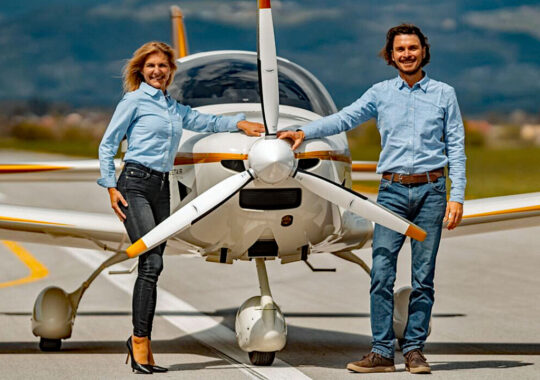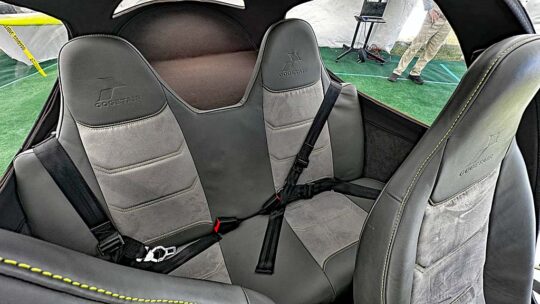Are you ready for Mosaic? Let’s be crystal clear. You have almost no time left to comment on FAA’s proposed rule. Mere days remain before the comment window closes. (Comment links at bottom)
However, we won’t see Mosaic LSA for many months yet. …Or, is that wrong? In this article, we look at G750, a 2+2 seat Mosaic LSA candidate.

After a group of maintenance organizations asked for more time, FAA extended the comment period to January 22, 2024. That means you have less than one week left as this article is posted. After that, FAA begins huddling internally to review all comments and make other changes (and hopefully fix a number of weak areas; see other reporting on Mosaic).

Many LSA producers are hustling hard to develop existing models into larger, more capable mLSA. A few brands are already flying and I have reported on several of these.
Go Get Some Air
In this article I want to explore the GoGetAir Aircraft G750. This Slovenian design is a new-to-Americans aircraft, though it has a decade of history in Europe.

Today, GoGetAir and their G750 are today the product of Ania and Iztok Šalamo (nearby image). They are well positioned for the coming Mosaic LSA class.

“GoGetAir is the only aircraft in the category that features large forward-and-upward-hinging doors for easy entry,” said the Šalamos, referring to them as “Lamborghini-style doors.” They added, “Pilot and passengers are protected with a Formula-1-like full-carbon roll cage with kevlar protection.
“In addition, every G750 is equipped with a BRS Parachute System,” GoGetAir said, “designed around a solid-fuel rocket housed in the front fuselage that pulls the parachute to full deployment within seconds.”

Though the term is no longer common, “2+2” indicates a second row of seats but ones with a lesser amount of leg room. A Cirrus SR20 weighs about twice as much as G750 but has a roomy aft seat.

G750 also demonstrates style and a beautifully compound-curved leading and trailing edge wing.
GotGetAir observed, “G750’s aft seat can be used for baggage or you can also take two children up to 55 pounds each and not more than five feet tall. When those aft seats are filled, some baggage can still be stored in the small space behind the seats.”
Even though you cannot fill G750 with four large American males, this is an ideal Mosaic LSA for Sport Pilot certificate holders. Those pilots will not be allowed to take four persons aloft but might enjoy the extra cabin space.
G750 Performs
Offered first with the 100-horsepower Rotax 912, a 115-horsepower Rotax 914 turbo engine enabled more robust performance with take-off in less than 500 feet and a climb rate more than 1,000 feet per minute

GoGetAir is reasonably fast, a nice bump from today’s LSA, offering cruise at 138 knots or 159 miles per hour. Other Mosaic LSA may strive for higher speeds but may be more compact to reduce drag. G750 is intended for comfortable cross country travel.

“Due to its huge flaps G750 is easily operated on 1,500 foot runway,” said GoGetAir. Stall speed for all three engine sizes is a modest 43 knots or 49 miles per hour. With Mosaic coming in at 54 knots (or possibly faster) G750 is well within Mosaic parameters.
GoGetAir G750
Safety Features
- Rocket-propelled emergency airframe parachute
- 4-mm-thick certified glass front windshield for bird and other object penetration protection
- Passenger compartment roll safety cage; designed and tested cabin construction with car-style crash resistance
- Doors designed to be opened in case of a roll-over
- Full Kevlar cabin interior for protection from object penetration
- “Single-spar” design — both spars overlap and are bolted together to the fuselage, adding to construction stiffness and safety
- Panel retracts in case of crash
- Three hinges on every moving surface; four on the flaps
- Glide ratio of 17.5:1 for lower fuel consumption and higher safety in case of engine failure.

G750’s 2+2 aft seats are for small children or other gear you may want to take along. Some baggage area is available aft of those seats.
GoGetAir in America
Shannon Hankins & Alan Jackson from Scissortail Aerosport represent G750 to North America. “Scissortail is the authorized North American Completion Center for the GoGetAir’s G750. We offer full in-house support during final assembly at our facility located in Tulsa, Oklahoma (KRVS).” Of course, their reference to assembly is before Mosaic when they could deliver a fully-built G750.

By the second quarter of 2025, Mosaic should become official regulation and then G750 will easily fit the mLSA category assuming the company chooses to pursue and declare compliance with ASTM standards.

While we all wait on Mosaic, Scissortail can refine their operation and deliver a few Experimental Exhibition aircraft to earn feedback from American pilots. Contact Shannon or Alan for more or to arrange a flight demo.
ARTICLE LINKS:
- Scissortail Aerosports, U.S. importer for GoGetAir, contact info and all related content on this website
- GoGetAir Aircraft, all contact information and content on this website
- Earlier reporting on Mosaic, multiple article with lots of detail plus many useful links
- For last-minute commenters, here’s FAA’s links:
- Make a comment, direct link to FAA’s make-a-comment page (comment period closes January 22, 2024)
- Read what 900+ other commenters have said on FAA comments-posted page


Interesting aircraft. It would be nice to get some dimensions (wing span, cockpit width, etc.). I’m wondering how they claim 7.2 hours at 6-7 gph and only 35 gals. of fuel? (referencing the Rotax 915iS engine) Would you cruise at less than 65% power to achieve this as you’d have to burn 5 gph with no reserves to get 7 hours of flight.